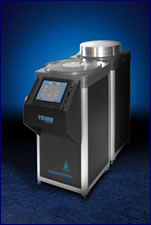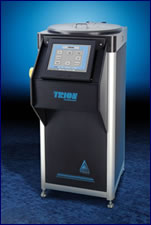MEMS
Posted by trion on Sep 16, 2014 in | 0 comments
Papers/ Applications Notes
Selective Reactive Ion Etching of P-Doped Polysilicon Using a Cl2/HBr Mixture
Trion Tool: Minilock-Phantom III RIE
“In this letter, a technique for carrying out smooth, selective, and anisotropic etching of p-doped polysilicon will be presented. …” Read the full article >>
PAPER: Controlled Multi-Batch Self-Assembly of Micro Devices
AUTHORS: Xiaorong Xiong, Yael Hanein, Jiandong Fang, Yanbing Wang, Weihua Wang, Daniel T. Schwartz and Karl F. Bohringer
APPLICATION: MEMS
TRION TOOL: RIE
KEYWORDS: micro assembly, self-assembly, hydrophobicity, capillary force, surface tension, interfacial energy, self-assembled monolayer, reductive desorption, electrochemical modulation, electroplating.
ABSTRACT: A technique is described for assembly of multiple batches of micro components onto a single substrate. The substrate is prepared with hydrophobic alkanethiol-coated gold binding sites. To perform assembly, a hydrocarbon oil is applied to the substrate and wets exclusively the hydrophobic binding sites in water. Micro components are then added to the water, and assembled on the oil-wetted binding sites. Moreover, assembly can be controlled to take place on desired binding sites by using an electrochemical method to de-activate specific substrate binding sites. By repeatedly applying this technique, different batches of micro components can be assembled to a single substrate sequentially. As a post assembly procedure, electroplating is incorporated into the technique to establish electrical connections for assembled components. Important issues presented are: substrate fabrication techniques, electrochemical modulation by using suitable alkanethiol (dodecanethiol), electroplating of tin and lead alloy and binding site design simulations. Finally, we demonstrate a two-batch assembly of silicon square parts, and electrical connectivity by electroplating contacts to surface-mount light emitting diodes.
PAPER: Double-sided micromachining process for silicon cantilever using a parallel capacitively coupled plasma
AUTHORS: Wei-Chih Wang, Joe Nhut Ho, and Per G. Reinhall (University of Washington)
APPLICATION: MEMS
TRION TOOL: Phantom RIE
ABSTRACT: A double-sided micromachining process for silicon-based device fabrication is developed that allows the use of capacitively coupled reactive ion etching (RIE) equipment for high-aspect-ratio etching. The effects of the masking materials and RIE conditions are discussed. Based on the experimental results, a 1000-A-thick Al film sufficiently protects the unexposed substrate while allowing the etching of a 350-m-deep hole with an area of 33 mm2 when etching with SF6/CHF3/O2plasma. A 2000-m-long and 100-m-wide (with layers of Al/SiO2/Si and thickness of 0.1/2.2/40 m, respectively) cantilever beam is achieved. A silicon etch rate up to 2.5 to 2.8 m/min is obtained and an anisotropy of A=0.5 (A=1-V/H, where V is the horizontal undercut and H is the etch depth) is obtained. The technique is developed mainly for bulk micromachining of silicon or composite silicon cantilever structures.
PAPER: Fully Micromachined Power Combining Module for Millimeter-Wave Applications
AUTHOR: Yongshik Lee (University of Michigan)
APPLICATION: MEMS Deep GaAs Etch
TRION TOOLS: RIE; Oracle Plasma Etch & Deposition System with Electrostatic chuck and He backside cooling
PAPER: Low-stress silicon carbonitride for the machining of high-frequency nanomechanical resonators
AUTHORS: L. M. Fischer; N. Wilding; M. Gel; S. Evoy (University of Alberta)
APPLICATIONS: Deposition, MEMS
TRION TOOLS: Phantom RIE; Orion PECVD
TOPICS: Infrared spectroscopy, Machining, Scanning electron microscopy, X-ray photoelectron spectroscopy, Tensile stress, Chemical vapor deposition, Nanoelectronics, Chemical elements, Surface and interface chemistry, Chemical bonding.
PAPER: Micromachining of non-fouling coatings for bio-MEMS applications
AUTHORS: Yael Hanein, Y. Vickie Pan, Buddy D. Ratner, Denice D. Denton, Karl F. Bhringer (University of Washington)
APPLICATION: MEMS
TRION TOOL: RIE
PAPER: Thermal Cycling Design Alternatives for the Polymerase Chain Reaction
AUTHORS: Monte Allen Lewis (University of Maryland)
APPLICATION: MEMS Medical
TRION TOOL: Minilock-Phantom RIE
ABSTRACT: PCR (polymerase chain reaction) is a process by which a small amount of DNA is amplified many times to yield an easily detectable amount. This process is widely used for the detection of bacterial pathogens for biodefense, in basic research, criminal identification, and disease detection in humans. The reaction mixture must be cycled repeatedly between three different temperature levels in PCR. The reaction mixture is first heated at 94 C, cooled to 54 C, and then heated to 72 C. This cycle is repeated 20-40 times. The main objective of the work reported here is to evaluate alternative heating/cooling schemes for PCR with the ultimate goal of speeding up a PCR reaction. A secondary goal is to arrive at a design that is consistent with battery operation to allow for a portable PCR device. Insight is gained about interactions between the PCR reaction and the engineering system.

Oracle Plasma Etch & Deposition System

Minilock-Phantom III RIE

Minilock-Phantom III RIE/ICP

Phantom III RIE

Orion III PECVD